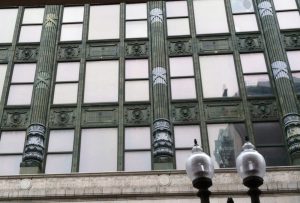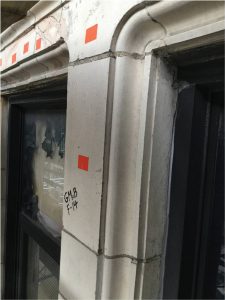Repair Options and Replacement Materials
The case to replace terra cotta in-kind with the integration of a corrosion mitigation system, rather than full-scale replacement or replacement with an imitation material, provides clients with a durable, long-term repair and restoration program that retains the original building fabric. This article discusses the history of architectural terra cotta and various repair options in lieu of stripping and replacing.
History and Use
Architectural terra cotta is one of the most beautiful, flexible, weather resistant building materials and can last thousands of years. Archaeological discoveries of terra cotta, or “baked earth,” date back to 3000 BCE. Its first use as a structural building material has been recorded in Italy in the 15th century. In America, the primary use of Architectural terra cotta in urban centers began in the 1850s and continued to soar throughout the early 20th century.
America was growing by leaps and bounds, adding roughly 35,000,000 immigrants to our nation from 1850 to 1930. Innovations like the elevator, initially invented in 1852, advancements in foundation engineering, and the use of steel frame construction helped to build beyond the typical 5-story walk up. Construction advancements were accommodating the flood of people into our bulging cities.
The new American Bourgeoisie, returning home from their “Grand Tours,” applied a newly learned artistic expression, influenced by the antiquities they discovered throughout Europe, to their corporate headquarters, residential towers, and the hotels ornamenting city skylines. The leading architects of the time, Richard Morris Hunt and H.H. Richardson, both studied at the L’Ecole des Beaux-Arts in Paris. The school was renowned for its neo-classical approach to design. Upon their return to the United States, Hunt’s and Richardson’s work influenced many leading American architects like Louis Sullivan, Daniel Burnham, and the battery of men who either followed or practiced directly under them.
As urban centers grew, earlier wood frame construction left cities like New York, Boston, Chicago, and San Francisco vulnerable to great fires. Prior to these fires, cast and wrought iron were employed in construction for use in some buildings dating back to 1793. After the great fires of the 1870s, the fireproof quality of steel and masonry construction was elevated.
This social, industrial, and disaster history led to a need for America’s growing, densely populated cities to have taller, fireproof buildings. The engineers and construction teams flexed their muscles, and the steel industry responded with innovative new materials. As developments in the steel industry occurred, improvements were made to its quality, strength, and manufacturing processes. With steel possessing better tensile qualities, less weight than cast or wrought iron, and competitive manufacturing, it became integral to American construction technology. By 1880, American skyscrapers were self-supporting steel “cages” decorated with classical ornamentation.
It was not always practical or economical for the tall steel frames to support solid, hand-carved stone. Terra cotta was an excellent substitute. Made of clay, its plasticity allowed it to be formed into any shape; the use of molds made it easier to mass produce high-quality beaux art design. Terra cotta units were hollow and significantly lighter than stone, and its compressive strength could support its own weight. Hence, a new non-load bearing enclosure for the metal skeletal structure, i.e., the curtain wall, was developed (Figure 1).
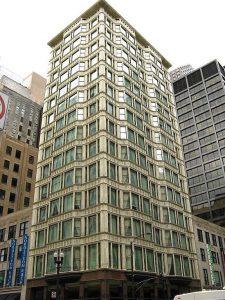
Figure 1. The Reliance Building, Burnham and Root/Atwood. Example of an early steel frame terra cotta clad building. Courtesy of TheArchitecturePost.com.
Historically, manufacturing methods were limited to hand pressing the clay into molds. Though modern methods of manufacturing such as extrusion, RAM pressing (a machine used to press clay into molded shapes), and slip casting are employed today to expedite the manufacturing process, modern ornamental architectural terra cotta still requires the touch of a classically trained sculptor or craftsperson.
In summary, terra cotta became an ideal building material because of its fireproof, light weight (lighter than cast stone), high compressive strength properties, and its ability to be easily molded and manufactured at a faster rate than stone could be carved. It could be used to mimic more expensive stone but became a creative tool for architectural expression in high-rise construction. The use of glazing allowed for a full-color range for material selection, further enhancing terra cotta’s versatility and waterproofing qualities.
Material Degradation
With properties similar to brick, the combined use of brick infill and terra cotta cladding became standard in late 19th– and early 20th-century skyscraper design. Terra cotta and brick are both clay-based materials with grog (finely ground pre-fired ceramic) and are fired in a kiln at approximately 2000 degrees Fahrenheit. The materials are compatible and work harmoniously. Terra cotta is held in place to back up wall construction with metallic anchorage and clamps.
Construction detailing became standardized by the National Terra Cotta Society, first in 1914 and again in 1927. By 1927, further details were developed in relation to material performance, accounting for expansion of the terra cotta, structural failure, and water management within the building envelope. Shelf supports, provisions for movement, freestanding construction, and flashing and drips were the most important principles upon which the standard was revised. It was also noted that “proper care should be exercised to prevent corrosion of all steel supports and ties. Where such protection cannot be permanently secured through mortar or concrete, or with corrosion resistant metallic coatings, non-corrosive metals should be employed.” While terra cotta was found to be a very durable building material, by the 1920s, it was recognized that moisture and corrosion were deleterious agents which would impact material performance if not managed appropriately.
Deterioration
Common modes of material failure for terra cotta include glaze and surface erosion, stress cracking from expansion, and deterioration caused by faulty craftsmanship. Most deleterious to the material is corrosion of the anchorage and steel frame. Other than craftsmanship defects, moisture ingress is a leading cause of the pervasive deterioration of terra cotta systems. Moisture penetrates the building system through failed joints, failed glazing, eroded surfaces caused by caustic cleaning or glaze degradation from atmospheric contaminants, or other waterproofing failures of the building envelope.
Moisture migration and movement through the building envelope of glazed terra cotta systems are prone to trapping moisture. This is due to the highly resistive and impermeable surface layer of the vitrified glaze, narrow mortar joints between units, and lack of weeps within the assembly. The material properties of the fired clay terra cotta body can retain moisture, keeping the infill and terra cotta unit damp. Retained moisture can lead to glaze spalling, cyclic freeze/thaw issues, and corrosion of the reinforcing steel.
Moisture and oxygen in the building envelope will incite corrosion of the steel frame and anchorage. This, in turn, cracks the masonry. As the cracks open, more oxygen and airborne particulates can reach the embedded steel. This increases rates of oxidation. Cracking caused by the accumulation of corrosion scale can destabilize terra cotta to the point of failure, leading to spalls and falling units.
Repair Options
Cracked and unsafe terra cotta units require replacement. Traditional repair options can be costly and disruptive to the building envelope. This entails stripping the terra cotta from the building to expose the frame and painting or waterproofing the steel. Where steel repairs are required, however, the frame itself must be accessed. After stripping and reinstating the masonry, repointing and waterproofing of the envelope are carried out. When making large-scale replacements, it is estimated that up to 30% of the surrounding material will be damaged by the repair. Often, spot replacement is performed instead of large-scale stripping due to cost and disruption to the building. If corrosion is left unmitigated, further damages will arise quickly in adjacent areas.
Replacement in-kind is always the preferable repair option when approaching a historic restoration, for landmark compliance, material compatibility, and durability. Spot repairs and alternate materials have been utilized in the recent past to reduce repair expenditures for full-scale terra cotta replacement.
Spot Replacement and ICCP
When conditions allow, a spot replacement program with terra cotta and an integrated impressed current cathodic protection system (ICCP) can provide a 25+ year repair. These systems control corrosion of the embedded steel, not surface erosion of terra cotta. ICCP systems are low-voltage DC systems that provide electrons to the steel from an external anode. This process controls the corrosion reactions. All the embedded steel becomes “cathodic” or protected. The systems are installed in the mortar joints and backup masonry material, and are then painted over. This allows for the original material to remain in place, while mitigating corrosion, and only requires “unsafe” cracked or damaged terra cotta units to be removed and replaced. These systems have been successfully used since 1991 in historic restorations. Aside from being sympathetic to the historical integrity of the structure, they ensure that future damages to the building envelope by corrosion are addressed (Figure 2).
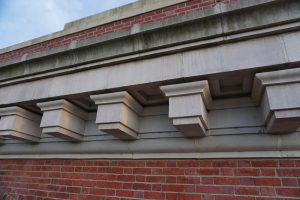
Figure 2. Terra cotta cornice spot replacement with ICCP in 2004. Two pieces of terra cotta were replaced on the full cornice, and the entire steel outrigger system is protected by Impressed Current Cathodic Protection.
Alternative Repair Materials
The use of alternative materials on terra cotta restoration projects has increasingly grown since the 1980s. Materials such as GFRC (glass fiber reinforced concrete), FRP (fiber reinforced plastic), cast stone units, and concrete resins are utilized. While these materials may have successful applications as independent building systems, their use as an alternative to terra cotta warrants on-going evaluation. When considering these materials, it is essential to understand the basics of the material components, how they differ in manufacturing from terra cotta, and ultimately their performance once installed in buildings.
GFRC is comprised of glass fibers in a cementitious matrix. During manufacturing, the material is spray applied into molds, and then a hand roller is used to bond the layers together. GFRC is not kiln fired; instead, it is cured for 24 hours to seven days depending on the manufacturer. GFRC is typically in molded panels, which allows for numerous repetitive masonry courses to be replicated in one piece and supported by hangers (i.e., cornices).
FRP is formed by pouring a polyester or resin into a mold. After this, tack-free layers of glass fabric are added with additional coats of resin. These are more lightweight than GFRC and, as non-loadbearing components, are used for lightweight elements in a building.
Cast Stone is comprised of a mixture of cements, aggregates, and mineral pigments using either a dry tamp or a wet cast process. Cast stone is not kiln fired; it is cured for approximately five days in various degrees of dampness. Like terra cotta, cast stone has been used as a decorative element in construction. Cast stone units often replace surface stone and ornamental features. All cementitious materials will shrink in service, thereby pulling the mortar joints into tension. To mitigate mortar cracking, control joints are incorporated, and soft joints must be placed between the dissimilar materials.
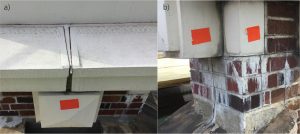
Figure 4. a) Full cornice replacement with GFRC. Note shrinking of sealant, opening of joints, water infiltration, and subsequent calcium leaching; b) Detail.
Concrete resins, or polymer concretes, are comprised of synthetic polymer resins with inorganic aggregates; the polymer replaces the lime or cement-based binder. These materials have significantly different performance attributes when compared to terra cotta. They are lightweight and non-structural in nature and are suitable to be suspended from anchorage or installed in a decorative capacity. Concerns regarding the flammability of earlier systems led to the development of newer mix designs to meet ASTM E84, “Standard Test Method for Surface Burning Characteristics of Building Materials,” criteria for flame resistance.
Conventional wisdom is to replace in-kind; when this cannot be done, limit the replacement to spot areas. While this is a conventional approach, the spot replacement using alternative materials will create a “Catch 22” situation. Whenever dissimilar materials are adjacent to one another, the stresses of the stronger material will be born upon the weaker material. The use of replacement materials should consider that the compressive strength, modulus of elasticity, coefficient of thermal expansion and contraction, water absorption, and ultraviolet stability will all differ. Often dissimilar materials do not bond equally and can allow water to seep into the structure, causing further damage. Therefore, it is important to recognize the common alternative materials that are dissimilar to terra cotta, manufactured differently, and ultimately perform differently once installed within the building envelope and wall system.
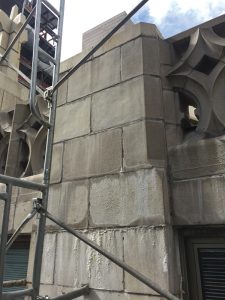
Figure 6. Full wall replacement cast stone units. Note the shrinkage, water infiltration, and leaching.
The observed performance of alternative systems has been documented with a select number of cases presented here (Figures 3-6). The defects illustrate material incompatibilities between existing terra cotta and new materials and are not a critique of alternative materials on their own.
Conclusions
Wholesale replacement is often considered the only alternative for terra cotta repair. Wholesale replacement can be costly and disruptive to the tenants and can be a scheduling concern. When an owner pushes back on these factors, teams often consider alternative materials for wholesale replacement. Although schedule may be slightly shorter, costs to the building, both initial and long-term, are not proven.
Methods such as reduced terra cotta in-kind replacement (replacing only pieces with visible cracks) along with cathodic protection offer cost savings to owners and provide the historic building with a long-term solution that honors its historic integrity. These systems are sympathetic to the building envelope in that no signs of the system are visible from the exterior, only the conduit and DC power supplies.
When looking for a long-term durable repair for deteriorated terra cotta, terra cotta itself must be considered the first option when replacing deficient material. When minimizing replacement pieces, spot replacement in-kind with cathodic protection will offer a 25+ year design. Overall, the long-term benefit of spot-replacement allows for physical, chemical, aesthetic, and material compatibility. Case studies demonstrating the success date back to the 1990s, with many American buildings having been treated in this manner. The targeted spot replacement allows for a reduced expenditure on terra cotta which minimizes corrosion damage to the façade, limits liabilities and reduces the risks of falling masonry.▪
References
Kurutz, Gary F.; Swisher, Mary (1989) Architectural Terra Cotta of Gladding, McBean. Sausalito, CA: Windgate Press
History.com Staff (2009) U.S. Immigration Before 1965. www.history.com/topics/u-s-immigration-before-1965
Alchin, Linda (2014) U.S. Immigration. Siteseen Limited www.emmigration.info
Nuttgens, Patrick (1997) The Story of Architecture. New York, NY: Phaidon Press, Inc.
Whirlwind Team (2014) The Evolution of Steel Buildings in The U.S. www.whirlwindsteel.com/blog/bid/383752/the-evolution-of-steel-buildings-in-the-u-s
Kelley, Stephen J., editor (1996) Standards for Preservation and Rehabilitation, Issue 1258. West Conshohocken, PA: ASTM
Martin, Bill & Wood, Chris (2015) Historic England Practical Building Conservation Earth, Brick & Terra Cotta. Burlington, VT: Ashgate Publishing Limited
Parks, Sharon (1988) Preservation Brief 16: The Use of Substitute Materials on Historic Building Exteriors. Washington, DC: National Park Service
Elder, Jeff (Structural Engineer & LEED, AP) (2010) AIA Presentation ISB-020 Reinforced Hollow Clay Masonry, Large Veneer
www.ball-consulting-ltd.com/gfrc.html
Atwood, Kelly R. (1999) An Assessment of Terra Cotta Replacement and Recommendations for The Belmont Pumping Station, East Fairmont Park, Philadelphia. A Thesis in Historic Preservation. Philadelphia, PA: University of Pennsylvania
De Teel Patterson, Tiller. (1979) Preservation Briefs No. 7: The Preservation of Architectural Terra Cotta. Washington, DC. National Park Service.

